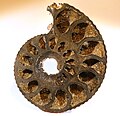Pyrite
Pyrite is a mineral from the sulfide group with the chemical formula FeS2. It is made up of 53.48% sulfur and 46.52% iron. Often solid, fine granular, sometimes radiated subfibrous; reniform, globular, stalactitic. Insoluble in water, and magnetic by heating. Its name derives from the Greek root pyr (fire), since when rubbed against metals it emits sparks, which intrigued the ancient world. Also known as "fools gold", "fools gold" or the "gold of the poor" for its great resemblance to gold.
Appearance
It has a cubic shape, the faces sometimes cemented, also often in octahedrons, pyritohedrons (twelve pentagonal faces) and rarely icosahedrons (twenty triangular faces). Often twinned, massive, radiated, granular, its color is brassy yellow and its luster is metallic, hardness: it is hard 6-6.5. It does not exfoliate, and the fractures are conchoidal (shell-shaped). Stripe color: blackish green, diaphaneity: opaque.
Pyrite melts easily, 2.5-3 on the Kobell scale, and releases sulfur vapors, leaving pyrrhotite as a solid residue.
Use
Pyrite is one of the minerals most used to obtain sulfuric acid (H2SO4) due to its high percentage of sulfur. The acid is obtained by "roasting" the mineral, that is, it is heated to high temperatures in the presence of oxygen, since this is how sulfur dioxide (SO2) emanates and later it is transformed artificially to sulfur trioxide (SO3) to which water is added to transform it into acid.
Gallery
The following images show different forms of pyrite:
Contenido relacionado
Uranium
Gene
Dactyloctenium




